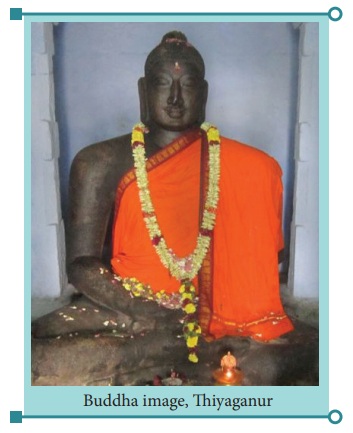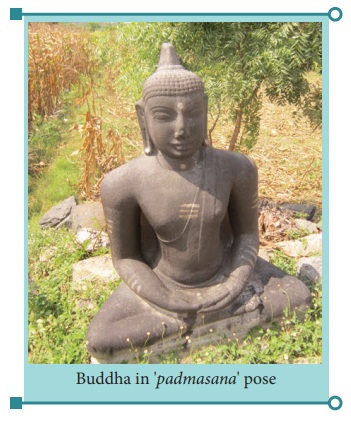Term 3 Unit 3 | History | 7th Social Science - Buddhism in Tamil Nadu | 7th Social Science : History : Term 3 Unit 3 : Jainism, Buddhism and Ajivika Philosophy in Tamil Nadu
Chapter: 7th Social Science : History : Term 3 Unit 3 : Jainism, Buddhism and Ajivika Philosophy in Tamil Nadu
Buddhism in Tamil Nadu
Buddhism
in Tamil Nadu
Buddhism
Buddha’s original name, Siddhartha
Sakya-muni Gautama, if translated into English, would mean Gautama who
belongs to the Sakya tribe and who has reached the goal of perfection. Gautama
Buddha was a contemporary of Mahavira. His father ruled the tribe of Sakya
in a region near the present-day Nepal. Gautama found that he had nothing to
learn from the teachers of the old religions. The religions proclaimed that the
only way to salvation was through living the life of an ascetic. But despite
practicing asceticism, Gautama could not arrive anywhere near the truth. And
one night, as he sat under a bodhi-tree struggling with his doubt and his
loneliness, a great peace descended on him. He was no longer Gautama, the
sceptic, but became Buddha, the Enlightened. At last, he had succeeded in
understanding the great mystery of human suffering, its causes and its cure.
Asserting that both the king (passion for pleasures) and the hermit
(self-mortifications) were wrong, he discovered the middle path. The middle
path is based on ‘an eight-fold path’ of Right understanding , Right thought,
Right speech, Right action, Right livelihood, Right effort, Right mindfulness,
Right concentration.
Buddha taught not the glory of God
but the power of love. He held the view that all men are born to an ‘equality
of rights’. He undertook long journeys and carried his message far and wide.
Buddha preached his teachings in Prakrit. His four noble truths are as follows:
1.
Life includes pain, getting old, disease, and ultimately death.
2.
Suffering is caused by craving and aversion.
3.
Suffering can be overcome and happiness attained.
4.
True happiness and contentment are possible, if one pursues the eight-fold
path.
Buddhist Literature
Buddha’s teachings for a long time
were transmitted through the memory of teachers and disciples. They were
reduced to writing by 80 B.C. and were written in the Pali language. The Pali
canon Tripitaka has three divisions, also known as the Threefold Basket.
They include Vinaya Pitaka, Sutta Pitaka and Abhidhamma
Pitaka.
Vinaya Pitaka contains the rules of the order of
Buddhist monks, which must be observed for achieving purity of conduct.
Sutta Pitaka lays down the principles of religion
by citing discourses as evidence.
Abhidhamma Pitaka is the latest of the Tripitaka.It
deals with ethics, philosophy and meta-physics.Other prominent canonical literary
works inBuddhism include:
Jatakas – various stories of the lives of
the Buddha found in Buddhist literature.
Buddhavamsa
– A legend in verse, containing
a narration of the life and activities of the 24 Buddhas who are
believed to have preceded Gautama. Apart from the above canonical literature,
there is a long series of non-canonical literature in Pali. They include:
* Milindapanha – which means ‘questions of
Milinda’. It contains a dialogue between Milinda, the Graeco-Bactrian king, and
the monk Nagasena over some problems that faced Buddhism. It was originally
written in Sanskrit.
*
The two famous Ceylonese chronicles are Mahavamsa and
Dipavamsa. The former deals with the royal
dynasties of the Indian subcontinent including Sri Lanka, while the latter deals
with the arrival of the Buddha’s teachings and preachers in Sri Lanka.
* Buddhagosha’s
Visuddhimagga is a later work. He is the first
Buddhist commentator.
*
Sanskrit literature became prominent in Buddhism with the rise of Mahayana
Buddhism. However, some of the Sanskritic works were produced by the Hinayana
school as well. Buddhacharita, written by Asvaghosa, is an epic style Sanskrit
work. It tells the life history of GautamaBuddha.
Buddhism in Tamizhakam
Buddhism is believed to have spread
to the Tamil country by the Ceylonese missionaries. The evidence in support of
this is some monuments of the Pandya country, which are assigned to the 3rd
century B.C. (BCE). The monuments are in caverns known as Pancha Pandava Malai.
Buddhism seems to have flourished and co-existed peacefully with Jainism,
Ajivikam and also with various sects of Hinduism. Since the time of Bhakti
Movement, Buddhism came to be challenged by its exponents and began to lose
royal patronage. The Thevaram hymns of Saiva saints and the Nalayira
Divyaprabandam of Vaishnava Azhwars provided evidence to the challenges
Buddhism faced in Tamil country. When Hieun Tsang, the Chinese traveller,
visited south India in the 7th century, Buddhism was almost on the decline.
But contrary to popular perception,
the Buddhism did not disappear completely. The presence of Virasozhiyam
(a 11th century Later Chola period grammar text, composed by a Buddhist) and
the discovery of 13th century Buddhist bronzes in Nagapattinam testify to the
presence of Buddhism in later periods. The sculptures of Buddha in Thiyaganur
village in Salem district strengthen this conclusion.

Though Buddhism faced challenges
from Saiva and Vaishnava sects from the Pallava period onwards. One of the
exceptions was Nagapattinam, which was supported by Chola kings, not for
religious but for political reasons. Chudamani Vihara of Nagapattinam was
constructed by the Srivijaya king with the patronage of Rajaraja Chola. This
vihara has been since destroyed. The Tamil epic, Manimekalai, written by
Kulavanigan Sithalai Sattanar, is considered a typical representation of Tamil
Buddhism. Sattanar indigenised Buddhism into Tamil Buddhism by communicating a
large set of Buddhist terms in Tamil, as translations from Sanskrit and Pali.
There is a record about a Buddhist
monk named Vajrabodhi, who was skilled in tantric rituals, but this monk left
the Pallava court for China. Mahendravarman’s Mattavilāsa Prahasana describes
Buddhism as a religion in decay.
In the field of education, Buddhist Sanghas
and Viharas served as centres of education. Students from
various parts of the world came here to receive education. Nalanda, Taxila and
Vikramshila gained reputation as great educational centres. They were
originally Buddhist Viharas. Students from Tibet and China were influenced by
Buddhism and they took effective steps to spread Buddhism.
A Vihara in Sanskrit means ‘dwelling’ or ‘house’. Originally,
viharas were dwelling places used by wandering monks during the rainy season.
Later they transformed into centres of learning through the donations of
wealthy lay Buddhists. Royal patronage allowed pre-Muslim India to become a
land of many viharas that imparted university education and were treasure
troves of sacred texts. Many viharas, such as Nalanda were worldfamous.

Viharas
Excavations of Buddhist Vihara and a
temple at Kaveripoompattinam and hundreds of stone and bronze sculptures by ASI
from over 125 sites have proved the spread of the religion in the state. A 1.03
metre Buddha statue in 'padmasana' pose in remote Tirunattiyattankudi
village in Tiruvarur district was unearthed when digging a tank in a field.

Related Topics